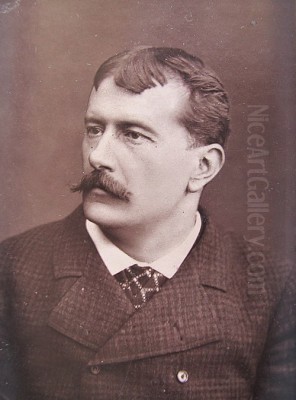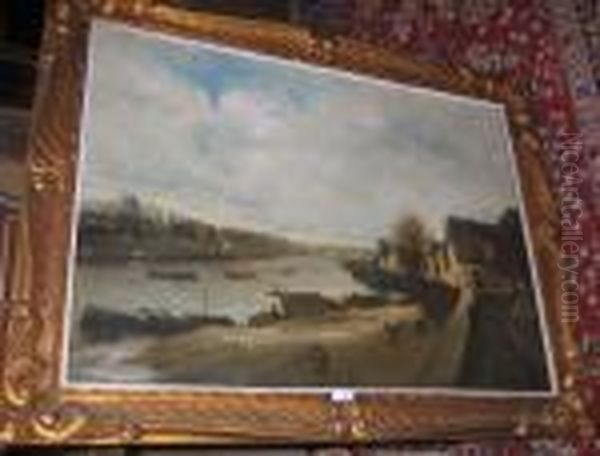
Jean-Baptiste Antoine Guillemet stands as a fascinating figure in nineteenth-century French art. Born in Chantilly in 1843 and passing away in Paris in 1918, his life spanned a period of immense artistic upheaval and innovation. Primarily known as a landscape painter, Guillemet navigated the complex art world of his time, maintaining connections with the avant-garde Impressionists while consistently finding success within the traditional structures of the Paris Salon. His work, often characterized by its clarity and atmospheric sensitivity, offers a valuable perspective on the transition from Realism and the Barbizon School towards Impressionism.
Early Life and Artistic Formation
Born into a family that initially might not have envisioned an artistic career for him, Antoine Guillemet's path towards painting was driven by personal inclination. While details of his formal training are somewhat scarce, suggesting he may have been largely self-taught or learned through informal mentorship, his early development was significantly shaped by his interactions with established artists. He did not follow the typical academic route through the École des Beaux-Arts as rigorously as some contemporaries.
Crucially, Guillemet formed a close and influential friendship with the renowned landscape painter Jean-Baptiste-Camille Corot. Corot's emphasis on capturing the nuances of light and atmosphere, his plein-air sketching practices, and his poetic yet truthful depictions of nature undoubtedly left a mark on the young Guillemet. This connection provided him not only with artistic guidance but also likely opened doors within the Parisian art community, linking him to the Barbizon tradition of landscape painting.
Artistic Style and Influences
Guillemet's style is primarily rooted in Realism and the traditions of the Barbizon School. Like painters such as Charles-François Daubigny, he was deeply invested in depicting the French landscape with fidelity and a keen sense of place. His subjects often included the coastal scenes of Normandy, the bustling quays and bridges of Paris along the Seine, and the quieter countryside environs. He possessed a strong ability to render the specific qualities of light and weather, capturing the crisp air of a winter morning or the hazy light of a summer afternoon.

While a close associate of the Impressionists, Guillemet never fully adopted their revolutionary techniques. His brushwork, though often lively and suggestive, generally retained more structure and definition than the broken colour and fleeting effects prioritized by artists like Claude Monet or Camille Pissarro. His compositions tend to be more traditionally grounded, maintaining a sense of solidity and spatial coherence. His palette was often bright and clear, reflecting the Impressionist interest in light, but typically applied with more tonal control. He remained committed to a form of naturalism that balanced direct observation with careful composition.
Key Works and Themes
Throughout his long career, Guillemet produced a substantial body of work, much of it centered on landscape and seascape painting. One of his most celebrated early works is Bercy en décembre (Bercy in December), exhibited at the Salon of 1874. This large-scale painting depicted the industrial quays along the Seine in winter with remarkable atmospheric accuracy and a modern sensibility, earning him critical acclaim and a second-class medal. It showcased his ability to find pictorial interest in contemporary urban or semi-urban landscapes, a theme also explored by many Impressionists.
His numerous views of the Normandy coast, particularly around Villers-sur-Mer and Le Havre, are also central to his oeuvre. Works like La Plage de Villers capture the expansive beaches, dramatic cliffs, and changing skies of the region. These paintings often feature broad horizons, detailed renderings of waves and sand, and a sensitivity to the specific light conditions of the Channel coast, echoing the work of Eugène Boudin, another painter of Norman seascapes whom Guillemet knew. His Parisian scenes frequently focused on the Seine, its bridges, and the surrounding architecture, capturing the life and atmosphere of the capital.
Salon Success and Recognition
Unlike many of his Impressionist friends who broke away to form their own independent exhibitions after facing repeated rejection from the official Salon, Guillemet consistently submitted his works and achieved considerable success within the established system. He began exhibiting at the Salon in the early 1860s and became a regular participant for decades. His technical skill, appealing subject matter, and style that balanced tradition with modern observation found favour with the juries and the public.
His Salon success was marked by official recognition. Following the positive reception of Bercy en décembre in 1874, he continued to garner awards and state purchases. His consistent presence and the honours he received, including being made a Chevalier of the Legion of Honour in 1880 and later an Officer, solidified his reputation as a respected establishment figure. This position sometimes put him at odds ideologically with his more radical friends, but it also allowed him a degree of influence and stability.
Relationship with the Impressionists
Perhaps one of the most intriguing aspects of Guillemet's career is his close and enduring relationship with the key figures of the Impressionist movement. He was a central figure in the social network of artists meeting at the Café Guerbois and later the Nouvelle Athènes. He counted Édouard Manet among his closest friends; Manet famously painted a striking portrait of Guillemet in 1880, depicting him casually leaning against a balcony railing with Paris visible behind him, a testament to their bond.
Guillemet played a crucial role as a connector. Famously, it was Guillemet who introduced the then-struggling Paul Cézanne to Manet, a significant moment in the younger artist's career development. He was also on friendly terms with Claude Monet, Pierre-Auguste Renoir, Edgar Degas, Camille Pissarro, Alfred Sisley, Berthe Morisot, and Frédéric Bazille. He shared landscape painting excursions and participated in the lively debates that shaped the future of modern art.
Despite these close ties, Guillemet generally declined to participate in the independent Impressionist exhibitions, preferring the official Salon route. Émile Zola, the novelist and art critic who initially championed Manet and the Impressionists, also praised Guillemet's early work, particularly Bercy en décembre. However, Zola later criticized Guillemet for what he perceived as a failure to fully embrace the more radical innovations of his friends, seeing his Salon success as a compromise. Guillemet's position highlights the diverse paths taken by artists during this era, even those within the same social circle.
Later Career and Legacy
Antoine Guillemet continued to paint and exhibit regularly throughout the later nineteenth and early twentieth centuries. His style remained largely consistent, focused on well-composed landscapes and seascapes rendered with atmospheric sensitivity. While he may not have pursued the radical formal experiments that characterized the later work of Monet or Cézanne, he maintained a high level of craftsmanship and continued to produce appealing works that found an audience.
His legacy is complex. While overshadowed in fame today by the core Impressionist masters, Guillemet was a highly respected and successful artist in his own time. His work provides a valuable link between the Barbizon tradition of Corot and Daubigny and the emerging Impressionist aesthetic. He absorbed aspects of the new movement, particularly its emphasis on light and contemporary subjects, but integrated them into a more structured, Salon-acceptable framework.
Furthermore, his role as a friend, supporter, and social facilitator within the Impressionist circle cannot be overlooked. His friendships with Manet, Monet, Renoir, Pissarro, Cézanne, Degas, Sisley, Morisot, Bazille, and his connection to older figures like Corot and contemporaries like Boudin and Johan Barthold Jongkind, place him at the very heart of the artistic dialogues of his time. Jean-Baptiste Antoine Guillemet remains an important figure for understanding the nuances and personal connections that shaped the landscape of French painting in the latter half of the nineteenth century. His paintings endure as skillful and evocative depictions of the French landscape and the era in which he lived.